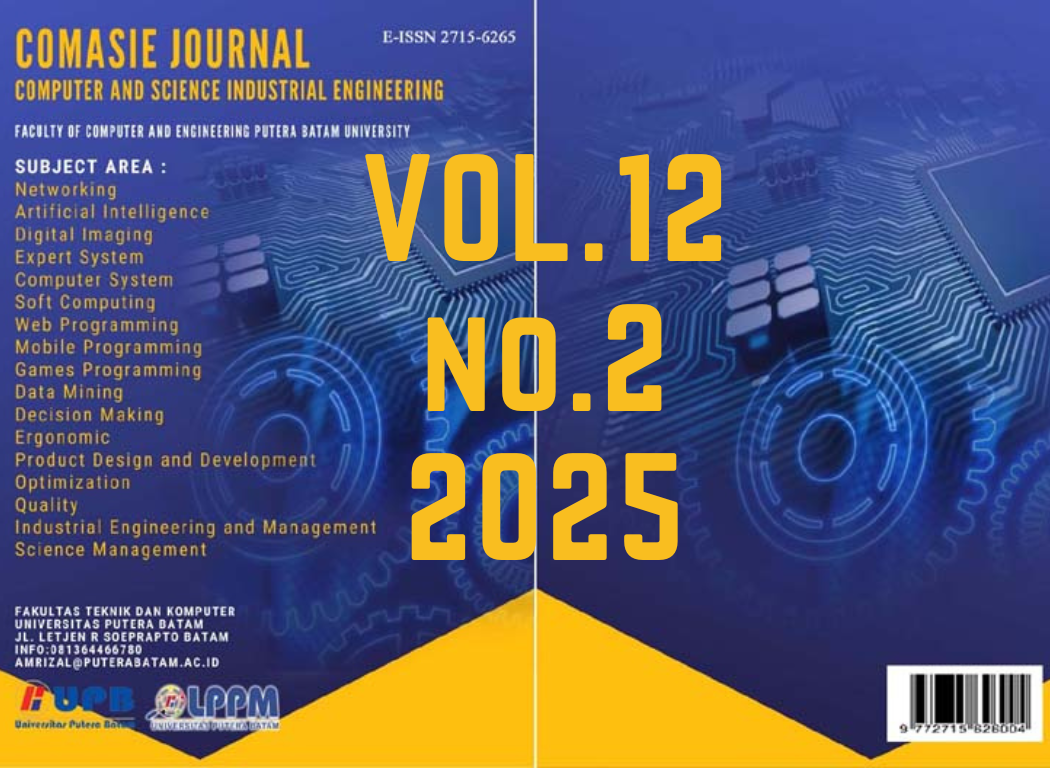PENERAPAN KLASIFIKASI CITRA PADA IDENTIFIKASI OBJEK DENGAN PAKAIAN SAFETY MENGGUNAKAN CONVOLUTIONAL NEURAL NETWORK DI PT JAYATAMA SAFETINDO.
DOI:
https://doi.org/10.33884/comasiejournal.v12i2.9647Keywords:
Convolutional Neural Network, Deep Learning, TensorflowAbstract
Construction workers are essential to project execution but face high risks of workplace accidents, often caused by human factors. Advances in artificial intelligence, particularly image processing, provide opportunities to improve the detection of personal protective equipment (PPE), which is currently checked manually and inefficiently. PPE, such as
gloves, helmets, and safety shoes, is vital for worker safety but is often neglected due to discomfort. This study uses Convolutional Neural Network (CNN) algorithms to classify images and verify PPE usage at construction sites. CNN processes spatial information through layers for feature extraction, dimension reduction, and classification. A previous
study with Faster R-CNN achieved accuracies of 72.83% with TensorFlow and 88.07% with Faster R-CNN. Using a dataset of 200 images, this research, conducted at PT JAYATAMA SAFETINDO, applies Python and TensorFlow to improve PPE detection accuracy. The results aim to support safer workplaces, enhance productivity, and advance AI applications in safety and identification.
References
Adiwibowo, Jonathan, Kartika Gunadi, and Endang Setyati. 2020. “Deteksi Alat Pelindung Diri Menggunakan Metode YOLO Dan Faster R-CNN.” Jurnal Infra 8(2):106–12.
Saragih, S. P. ., & Silalahi, M. . (2023). Aplikasi Web Pengendalian Maintenance Mesin Berbasis Data PLC. Jurnal Desain Dan Analisis Teknologi, 2(2), 187–192. https://doi.org/10.58520/jddat.v2i2.37
Caggiano, Alessandra, Jianjing Zhang, Vittorio Alfieri, Fabrizia Caiazzo, Robert Gao, and Roberto Teti. 2019. “Machine Learning-Based Image Processing for on-Line Defect Recognition in Additive Manufacturing.” CIRP Annals 68(1):451–54. doi: 10.1016/j.cirp.2019.03.021.
Saragih, S. P. (2019). TECHNOLOGY ACCEPTANCE OF DIGITAL PAYMENT SYSTEM PADA PELAKU UMKM DI KOTA BATAM. Computer Based Information System Journal, 7(2), 82–90. https://doi.org/10.33884/cbis.v7i2.1402
Cheng, Jack C. P., Peter Kok Yiu Wong, Han Luo, Mingzhu Wang, and Pak Him Leung. 2022. “Vision-Based Monitoring of Site Safety Compliance Based on Worker Re-Identification and Personal Protective Equipment Classification.” Automation in Construction 139. doi: 10.1016/j.autcon.2022.104312.
Galos, Joel, and Xiaoying Wang. 2024. “Demonstration of Computer Vision for Void Characterisation of 3D-Printed Continuous Carbon Fibre Composites.” Results in Materials 22(February):100566. doi: 10.1016/j.rinma.2024.100566.
Laily, Milzamah Elvi, Fathorazi Nur Fajri, and Gulpi Qorik Oktagalu Pratamasunu. 2022. “Deteksi Penggunaan Alat Pelindung Diri (APD) Untuk Keselamatan Dan Kesehatan Kerja Menggunakan Metode Mask Region Convolutional Neural Network (Mask R-CNN).” Jurnal Komputer Terapan 8(2):279–88. doi: 10.35143/jkt.v8i2.5732.
Mentari, Trinita Septi, and Info Artikel. 2020. “Kepatuhan Pemakaian Alat Pelindung Diri Pada Pekerja Proyek.” Higeia Journal of Public Health Research and Development 4(4):610–20.
Nath, Nipun D., Amir H. Behzadan, and Stephanie G. Paal. 2020. “Deep Learning for Site Safety: Real-Time Detection of Personal Protective Equipment.” Automation in Construction 112(July 2019):103085. doi: 10.1016/j.autcon.2020.103085.
Sukma Ika Noviarmi, Fadilatus, and Lanobyan Hamengku Prananya. 2023. “Hubungan Masa Kerja, Pengawasan, Kenyamanan APD Dengan Perilaku Kepatuhan Penggunaan Alat Pelindung Diri (APD) Pada Pekerja Area PA Plant PT X.” Jurnal Keselamatan Kesehatan Kerja Dan Lingkungan 4(1):57–66. doi: 10.25077/jk3l.4.1.57-66.2023.
Syafiq, Umar, and Surya Perdhana. 2018. “Kecelakaan Kerja Pada Perusahaan Konstruksi: Sebuah Telaah Literatur.” Diponegoro Journal Of Management 7(1981):1–9.
Vrontis, Demetris, Michael Christofi, Vijay Pereira, Shlomo Tarba, Anna Makrides, and Eleni Trichina. 2022. “Artificial Intelligence, Robotics, Advanced Technologies and Human Resource Management: A Systematic Review.” International Journal of Human Resource Management 33(6):1237–66. doi: 10.1080/09585192.2020.1871398














